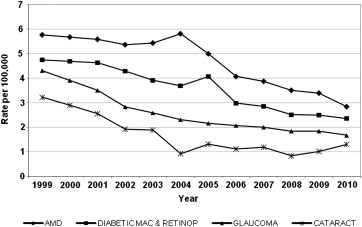In a recent issue of the Journal, we published an article showing that the age-standardized incidence rate of newly registered legal blindness in Israel was halved in the decade between 1999 and 2008, declining from 33.8 to 16.6 per 100 000 in 2008. This dramatic decrease was attributed to a decreased incidence of blindness resulting from age-related macular degeneration (AMD), glaucoma, diabetic maculopathy and retinopathy, and cataract. These data were obtained from the national registry of people who were issued a personal certificate of blindness by the Israeli Ministry of Social Affairs to all individuals who meet the criteria of legal blindness: visual acuity of less than 3/60 or a visual field of less than 20 degrees in the less-impaired eye. We recently analyzed the data for the years 2009 and 2010 and found a continuation of the rapid decline in the incidence of new cases of blindness from all major causes except cataract.
The overall rate of blindness per 100 000 people declined from 16.6 in 2008 to 14.8 in 2010. The disease-specific rates for the corresponding years ( Figure ) were: 3.51 and 2.84, respectively, for AMD; 2.52 and 2.36, respectively, for diabetic maculopathy and retinopathy; and 1.84 and 1.68, respectively, for glaucoma. The number of individuals recognized as blind as a result of cataract increased from 78 to 129. It may be assumed that these figures represent a parallel diminution in the number of people afflicted with visual impairment short of blindness.





